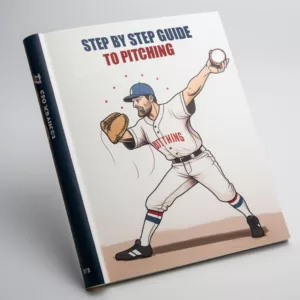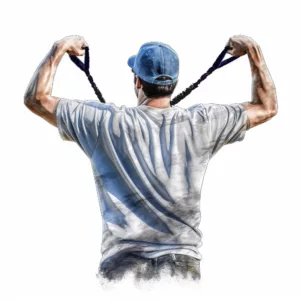Are you an aspiring baseball player looking to improve your throwing skills? Whether you're a beginner or a seasoned player, learning how to throw a baseball accurately and with velocity is a fundamental skill that can greatly impact your game. In this article, we'll guide you through the step-by-step process of throwing a baseball, discuss common throwing techniques, provide tips for improving accuracy and velocity, and highlight the importance of proper mechanics and injury prevention. So grab your glove, and let's dive in!
Understanding the Basics of How to Throw a Baseball
 Before we delve into the specifics, let's start by understanding the basic elements of a proper baseball throw. Two key factors play a crucial role in a successful throw: grip and hand placement, and stance and body position.
Before we delve into the specifics, let's start by understanding the basic elements of a proper baseball throw. Two key factors play a crucial role in a successful throw: grip and hand placement, and stance and body position.
Grip and Hand Placement
The grip and hand placement are essential for maximizing control and spin while throwing a baseball. The most common grip is the four-seam grip, where the index and middle fingers are placed across the seams, and the thumb is positioned underneath the ball for support. This grip allows for a stable release and better accuracy.
Stance and Body Position
The stance and body position also contribute significantly to the effectiveness of a throw. When preparing to throw, stand with your feet shoulder-width apart, with your throwing arm side facing the target. Maintain a slight bend in your knees and keep your body balanced to ensure a strong and accurate throw.
Step-by-Step Guide on How to Throw a Baseball
 Now that we've covered the basics, let's walk through the step-by-step process of throwing a baseball. By following these instructions, you can develop a solid throwing technique that will help you excel on the field.
Now that we've covered the basics, let's walk through the step-by-step process of throwing a baseball. By following these instructions, you can develop a solid throwing technique that will help you excel on the field.
Step 1: Starting Position
Begin by assuming a proper starting position. Stand with your feet shoulder-width apart, facing your target. Hold the baseball with a four-seam grip, ensuring your fingers are across the seams and your thumb is positioned underneath the ball.
Step 2: Windup
Move into a windup position by lifting your lead leg and bringing it towards your chest while simultaneously breaking your hands apart. This windup helps generate power for your throw.
Step 3: Stride and Arm Action
As you begin your stride, fall forward with your lead leg slowly positioning itself for landing while simultaneously bringing your throwing arm backward. Ensure that your arm remains cocked and ready to release the ball at landing.
Step 4: Release and Follow-Through
After landing, launch your trunk forward while your arm action syncs with your trunk movements. Focus on a smooth and fluid motion, allowing the ball to leave your hand with proper velocity and accuracy.
Common Throwing Techniques on How to Throw a Baseball
 Now that you have the basic throwing mechanics down, let's explore some common throwing techniques used in baseball.
Now that you have the basic throwing mechanics down, let's explore some common throwing techniques used in baseball.
- Overhand Throw: The overhand throw is the most common throwing technique used in baseball. It involves throwing the ball over the top of your shoulder in an upward motion, providing good accuracy and velocity.
- Sidearm Throw: The sidearm throw is characterized by a lower release point, where the arm is extended horizontally rather than over the top. This technique can be effective in certain situations, such as quick throws from the outfield or infield.
- Submarine Throw: The submarine throw is a unique technique where the ball is released from a sidearm position but with an extremely low release point. This technique can create deceptive movement and is often used by pitchers to confuse hitters.
Tips for Improving Throwing Accuracy and Velocity
Throwing a baseball with accuracy and velocity requires practice and refinement. Here are some valuable tips to help you improve your throwing skills:
- Practice Drills: Incorporate specific drills like the TopVelocity Drills into your training routine to enhance your throwing abilities. Focus on exercises that emphasize proper mechanics, target accuracy, and arm strength which you can find in the 3X and 2X programs.
- Strengthening Exercises: Strengthening your muscles is crucial for improving velocity and reducing the risk of injury. Include exercises such as squats, cleans, and resistance band workouts to build arm strength.
- Focus on Mechanics: Pay close attention to your throwing mechanics, including your grip, arm action, and follow-through. Seek guidance from coaches or trainers to identify any flaws in your technique and make necessary adjustments.
Importance of Proper Mechanics and Injury Prevention
 Proper throwing mechanics not only improve performance but also reduce the risk of injuries. It's essential to prioritize the following aspects for both effectiveness and injury prevention:
Proper throwing mechanics not only improve performance but also reduce the risk of injuries. It's essential to prioritize the following aspects for both effectiveness and injury prevention:
- Proper Warm-up: Before engaging in any throwing activity, warm up your muscles with dynamic stretches and light throwing. This prepares your arm for the demands of throwing and helps prevent strain or injury.
- Avoiding Common Mistakes: Be mindful of common mistakes such as overstriding, poor posture, or aggressive arm action. These errors can lead to diminished accuracy, decreased velocity, and increased risk of injury.
- Preventing Overuse Injuries: To avoid overuse injuries, such as pitcher's elbow or rotator cuff strains, it's crucial to monitor your throwing workload. Gradually increase throwing intensity and take regular rest periods to allow for proper recovery.
Conclusion
Throwing a baseball effectively requires a combination of proper technique, practice, and a focus on mechanics. By following the step-by-step guide we provided, mastering the art of throwing a baseball can become an attainable goal. Remember to incorporate specific drills, strengthen your arm, and prioritize injury prevention. With dedication and persistence, you'll see improvements in your accuracy, velocity, and overall performance on the field.
FAQs on How to Throw a Baseball
FAQ 1: How long does it take to master the art of throwing a baseball?
The time it takes to master throwing a baseball can vary depending on individual factors such as dedication, natural ability, and the amount of practice. With consistent effort and focused training, significant progress can be made within a few months to a year.
FAQ 2: Can anyone learn to throw a baseball?
Yes, anyone can learn to throw a baseball with proper instruction, practice, and determination. While some individuals may have natural talent or athleticism that provides an advantage, the basic throwing mechanics can be learned by anyone.
FAQ 3: How can I improve my throwing arm strength?
 To improve your throwing arm strength, incorporate strength and conditioning exercises into your training routine. Focus on exercises that target the muscles used in throwing, such as your legs, core, and arms. Some effective exercises include:
To improve your throwing arm strength, incorporate strength and conditioning exercises into your training routine. Focus on exercises that target the muscles used in throwing, such as your legs, core, and arms. Some effective exercises include:
- Shoulder Exercises: Perform exercises like shoulder presses, lateral raises, and external rotations using dumbbells or resistance bands. These exercises strengthen the muscles around the shoulder joint, enhancing stability and power.
- Leg Exercises: Include leg exercises like squats, lunges, and clean exercises using barbells. Strong legs provide better control and stability during the throwing motion.
- Core Strengthening: A strong core is essential for generating power and transferring energy from your lower body to your throwing arm. Incorporate exercises such as planks, Russian twists, and medicine ball rotational throws to strengthen your core muscles.
Remember to gradually increase the intensity and weight of your exercises to avoid overexertion or injury. Additionally, consult with a qualified strength and conditioning coach for a personalized program tailored to your specific needs.
FAQ 4: Are there any specific drills for improving accuracy?
Yes, several drills can help improve throwing accuracy. One effective drill is the target practice drill in the 3X Pitching Velocity Program, where you set up targets at various distances and try to hit them consistently with the optimal mechanics. Start with larger targets and gradually decrease their size as you improve. Another useful drill is the partner catch drill, where you and a partner stand at a distance and focus on throwing the ball with precision and control. Practicing these drills regularly can significantly enhance your accuracy over time.
FAQ 5: What are the most common throwing-related injuries?
Some common throwing-related injuries include pitcher's elbow (medial epicondylitis), rotator cuff strains, labral tears, and shoulder impingement. These injuries can occur due to overuse, poor mechanics, lack of proper warm-up, or inadequate strength and conditioning. It's essential to listen to your body, avoid overexertion, maintain proper mechanics, and incorporate a comprehensive warm-up and cooldown routine to prevent these injuries.
Remember, mastering the art of throwing a baseball takes time, effort, and patience. Consistent practice, attention to technique, and a focus on strength and conditioning will help you improve your throwing skills and elevate your game. So keep practicing, stay dedicated, and enjoy the journey of becoming a better thrower.

